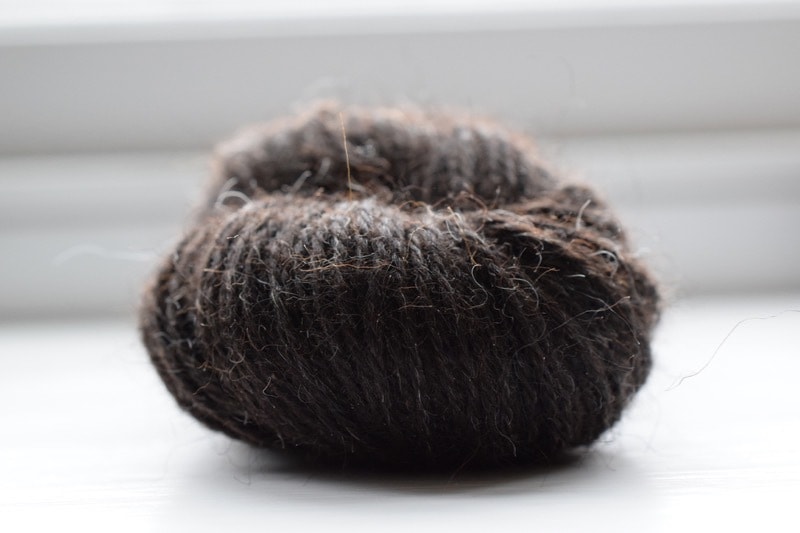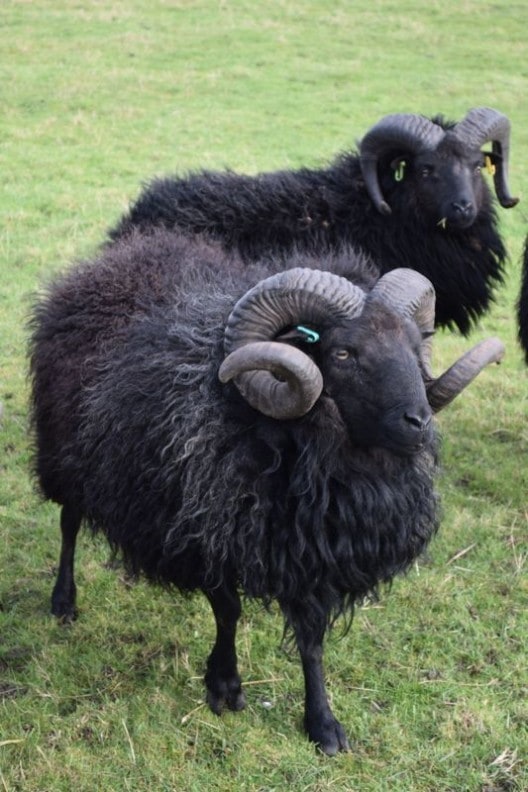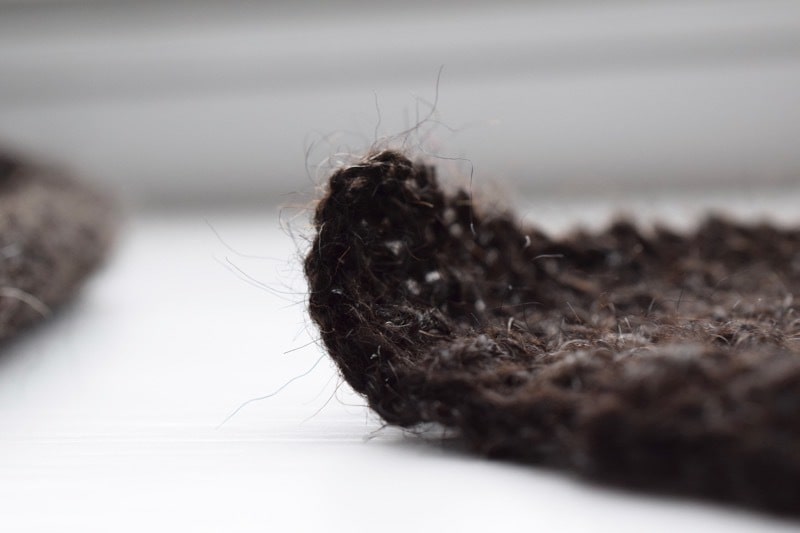Today I am absolutely delighted to welcome Rachel Atkinson to KnitBritish. Writer, designer, tech editor and soon to be wool merchant, Rachel is launching her Daughter of a Shepherd yarn this weekend, at Edinburgh Yarn Festival.
If you weren’t aware of Rachel’s recent wool journey, creating yarn from her dad’s Hebridean flocks, then I urge you to read her Fleeced post, at mylifeinknitwear.com
Rachel and I can – quite evidently – talk at length about wool and so to lengthen the tantalisation before the wool is launched, I am going to bring you our conversation in two parts.
LS: It’s so lovely to have you over at KnitBritish! It’s been about 6 months since your Fleeced post and you are now on the verge of launching the Hebridean yarn, from your Dad’s flock. This is incredibly exciting. I have been bouncing in anticipation since your post!
RA: Thank you so much – the excitement levels are currently at 11 and I can’t quite believe the yarn has landed and I’m actually knitting with it!
LS: Tell us a little bit about this journey; who else has been involved, given advice and helped make this yarn happen?
RA: It has been an amazing journey starting with Dad telling me they had received a cheque from the British Wool Marketing Board (BWMB) for the princely sum of 94 pence as part-payment for the 2014 wool clip. A visit to Gotland last summer to see Ann Myhre (pinneguri) got me thinking about how small mills produce wool on the island and how it is treated as a valuable commodity. You can buy skeins of spun wool from the farm shop right next to the field where the sheep are grazing – I wish we could have more of this in the UK. I can buy potatoes, eggs and meat direct from the farmer in my village, so why not wool?
British sheep breeds are wide and varied and the wool industry had been the backbone of the British economy since Medieval times, so why are we now importing so much raw wool? Why are British companies selling wool spun in Italy and China from fleece sourced on the other side of the world? And in turn, why is British fleece being exported and sold on elsewhere? So many questions and not very many answers and I digress!
Dad had his 2015 clip sat in a building – it wasn’t going to the BWMB following the pittance they had received the previous year, and would be more valuable used around the estate to protect trees and suchlike. Whilst visiting him in September for Yarndale he showed me the fleece and I started wondering…could it be possible to turn this into yarn for handknitting?
I took a fleece from the pile to give to my friend ‘Probably’ Jane Lithgow who I had promised one to for handspinning (you can see the finished yarn over on my blog) and whilst at Yarndale I chatted with Rachel Coopey, Jeni from Fyberspates and Joy from The Knitting Goddess all of whom recommended I speak to John Arbon. So I did, and the rest as they say is history!
There is a long list of thank yous to those who have supported me along the way but I absolutely couldn’t have done this without Dad and his partner Julia, my dear friend Susan Cropper of Loop, Anthony Duncan Smith who designer all the branding and last but not least Mr K who didn’t even flinch when I said I was going to spend the mortgage deposit money I’d saved on spinning some wool! I also have to thank each and every one of the blog readers, Twitterers, Instagrammers and people who have got in touch with messages of support along the way – they are the ones who made me believe this mad-cap scheme was a good idea.
If there wasn’t you, Miss Knit British, would it have happened? Maybe not!
LS: I love Hebridean wool – I am a bit biased about North European short tailed primitives, being a Shetlander and loving that breed’s wool, but Hebs are really distinctive too aren’t they? Their fleece has such character and range, which makes a really interesting yarn, as Jane showed when she spun some for you. Has it always been Hebrideans that your dad has kept?
RA: Dad started with Suffolks which he bought to train his Border Collie on and I think he has also kept Swaledales, Scottish Blackface and Welsh Blacks. The Hebrideans he currently shepherds include his own flock and those which are kept on the Escrick Park Estate for conservation grazing. It’s an amazing scheme and something I’m hoping to learn a little more about this year. Hebrideans are perfect for maintaining wooded areas and rough grasses and will happily potter about in undergrowth and woodland and grazing on all the things nobody else wants, gradually cleaning up and keeping the area tidy.
Their fleeces tell the story of their year – starting from a deep pitch brown ad then depending on how much sun there has been they will develop golden and tan highlights with the fleece becoming speckled with grey and silver as and as the animals age. It’s really fascinating.
LS: I know you grew up having kept sheep but had you worked with their wool much before making the decision to make yarn?
RA: The arrival of Daughter of a Shepherd yarn is the first time I will have worked with wool from one of Dads flocks. I remember Mum processing, spinning and knitting an Aran sweater for Dad in what I think will have been Suffolk fleece…I also remember her cursing every minute of it!
LS: Ok, C’mon then….what can you tell us about your yarn, and how does it feel to go from wool lover to wool purveyor and merchant?
RA: Wool purveyor and merchant, now there’s a title I like a lot. Mind if I pinch that one? In fact I might already have done so! It feels incredible and not quite real and I am sat here typing surrounded by boxes filled with yarn that we didn’t even know would be possible 6 months ago – it’s amazing.
I had to go into this project with an open mind and see what would happen as I was never sure if the fleece was going to survive scouring and then if it would be good enough to spin, so I left a lot of the major decisions (such as the processing and type of spin) in the hands of the professionals. The only thing I was adamant about was that it had to be 100% British from source, through processing and spinning, and I hoped we could spin it to a DK weight, but apart from that I have listened to advice from people who are experts in their fields. You have to listen to the experts and be prepared to adapt to what is best for the end product.
One thing I am particularly proud of is that I think my yarn might just have the capability to prove that not all primitive, dark coloured sheep breed fleeces are only ‘good’ for carpet and also that it doesn’t even have to be a rustic yarn – there’s a real elegance to the Daughter of a Shepherd yarn which make it a joy to work with and to wear.
And hoorah for promoting the elegance of British breed wool! Come back later this week to discover more about Daughter of a Shepherd yarn, about the importance of labelling and of our thoughts on the future of British wool. In the meantime ensure you sign up for the Daughter of a Shepherd newsletter and join in with the Ravelry group too.
All images ©Rachel Atkinson and used with kind permission.






As the owner of a 10 month old yarn shop which specialises in British wool this article gladdened my heart. Wishing Rachel every success and please may I have some yarn for the shop!
What a truly wonderful and brilliant post to read…I can’t wait for this wool to go on sale, ever since reading Rachel’s “fleeced” post back in October/November I’ve been wanting to pick up that wool to feel and smell, squish and just love it.
Will Rachel be bringing out any patterns (or suggesting any) that will really show this woolly yarn off to it’s best potential? I’m thinking something that echoes the ridges from those gorgeous horns would be pretty neat.
This yarn is at the top of my must buy list at EYF, I can’t wait.
Wonderful! I love reading about your British breeds!
I’m so keen to try some DoaS yarn! Looking forward to part 2 of the interview.
[…] year’s EYF is also going to see the unveiling of Rachel Atkinson’s Daughter of a Shepherd yarn; I have watched this unfolding story with increasing glee and we wrote about it for Wovember; I am […]
After reading her heart breaking post last year, it’s great to see Rachel’s plans almost at fruition – and presumably since it’s the 18th today, now launched. Wishing her luck and thanking you for encouraging all the knitbritishness everywhere.
Will we be able to buy your wool in the states? I would love to try it.
[…] John Arbon Textiles also spun a very special debut yarn, Daughter of a Shepherd, for Rachel Atkinson. I stopped by her stand to meet and chat with Rachel about her new yarn, which is incredible in so many ways. Rachel used the fleeces from her father’s flock of Hebridean sheep, which the British Wool Marketing Board basically declared worthless, to create this beautiful undyed yarn. I love the tag, which lists the shepherd’s name (her father) as well as the date of the clip. Read the story of this yarn and learn a bit about the British wool industry on Rachel’s blog or in her interview with Knit British. […]
Good luck with your launch and future plans. A huge thank you for promoting Northern European short tailed sheep and fleece. As a breeder of Icelandic sheep here in the Highlands ( I had intended to have Hebs on the croft but became the accidental owner of a flock of pedigree Icelandics) can I say I whole heartedly support what you are doings and I will follow with interest. We need more micro mills and definitely need some sort of community project up here the Highlands (similar to Uist and North Ronaldsay) that could spin low volume clips so crofters could sell yarns, as you say alongside the lamb, beef, pork and other croft produce. SCF (Scottish Crofting Federation) already have a quality mark for croft produce that is available to crofters, we just need investment in the infrastructure in the form of micro mills and the staff trained to produce quality British bred and grown yarns from fleece that BWMB are not interested in (particularly the naturally coloured fleeces) The existing mills which take small quantities are building waiting lists and costs for small producer are prohibitive.
hi there! This post is from a couple of years ago but Rachel has now added other British breed yarns to her hugely successful hebridean wool.
You are so right about needing more mills & infrastructure for a wool industry. coincidentally, the border mill in Duns can spin as little as a few kilo of fleece.